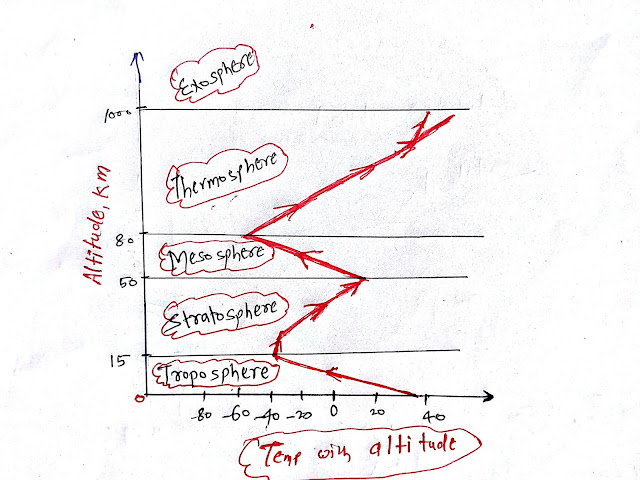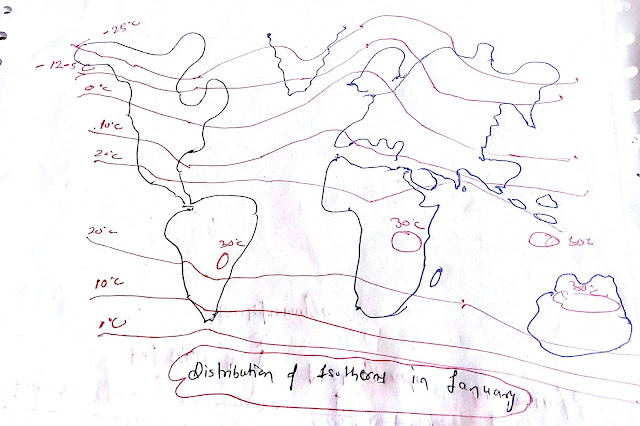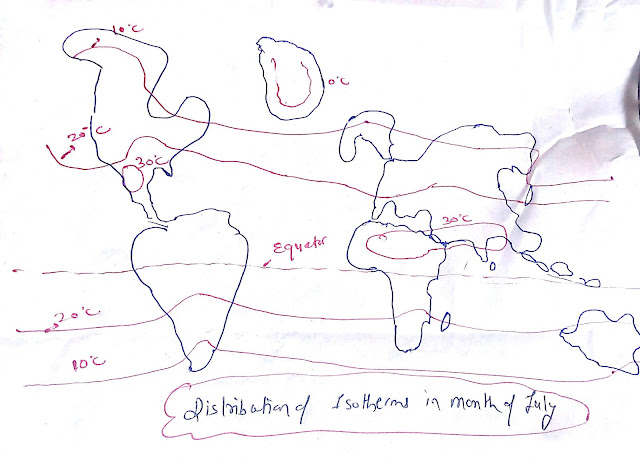Table of Contents:
- What is Atmospheric temperature
- Sources of Temperature
- Factors Controlling temperature Distribution
- Distribution of Temperature
- Vertical Distribution
- Normal Lapse Rate
- The humid adiabatic lapse rate
- The dry adiabatic lapse rate
- Thermal Inversion
- Mechanical instability
- Horizontal Distribution
- Isotherms
- Thermal anomaly
- Thermal Gradients
Atmospheric Temperature:
The heat energy that trapped in our atmospheric components such as air, dust and water vapor is called atmospheric temperature.
Temperature is being measured by centigrade, Fahrenheit, and Kelvin.
Temperature is being measured by centigrade, Fahrenheit, and Kelvin.
Source of Atmospheric temperature:
The following are two types of temperature sources:- Natural source
- Artificial source
Natural source:
- Insolation
- Longwave terrestrial radiation
- Volcanic activities
- Interior earth
Insolation:
As we know, the atmosphere has a total of 135 units of heat balance in the heat budget of the earth. The atmosphere gets 17 Units ( 2 units absorbed by Ionosphere and stratosphere, 15 units absorbed by water vapor) of heat through insolation, considering 100 units of heats received at thermopause, 1000 kilometer of height from the earth surface.
Please refer heat budget page for more details: Heat budget
Longwave terrestrial radiation:
The largest portion of the atmosphere of the heat gets from longwave terrestrial radiation. As 118 unit (5 by conduction, 91 radiated from land, and 22 units radiation from the ocean) out of 135 units of atmospheric heat balance, the atmosphere receives from longwave terrestrial radiation.
The long wave terrestrial radiation heats the atmosphere from earth's surface because heavy air, dust particles, and water vapor are present as in large quantity near to earth surface and trapped outgoing long-wavelength terrestrial radiation first in large quantity, hence temperature decrease when we go up from earth surface.
Volcanic activities:
The fraction of atmospheric heats also emits to the atmosphere by a volcanic eruption.
The long wave terrestrial radiation heats the atmosphere from earth's surface because heavy air, dust particles, and water vapor are present as in large quantity near to earth surface and trapped outgoing long-wavelength terrestrial radiation first in large quantity, hence temperature decrease when we go up from earth surface.
Volcanic activities:
The fraction of atmospheric heats also emits to the atmosphere by a volcanic eruption.
Artificial source:
- Industrialization and transportation
- A forest fire and cooking fuel burning
- Slash and burn agriculture and many more.
Factors Controlling Temperature Distribution:
The temperature of any place is influenced by the following way:- the latitude of any place
- the altitude of any place
- the distance from the sea
- influence of warm and cold ocean current
- Some local aspect such as eas and west-facing things get more insolation as compare to north and south-facing
Global Distribution of temperature:
- Vertical Distribution
- Horizontal distribution
Vertical distribution:
The vertical distribution of temperature is highly variable throughout the atmospheric layer, the following diagram shows the vertical distribution. |
| Vertical distribution of temperature |
Within the troposphere, the vertical distribution of temperature is highly variable in both spatial and temporal ways. The vertical distribution of temperature in the troposphere can be understood by study the lapse rate in different regions. The following are the different types of lapse rates.
- Normal Lapse rate
- Thermal Inversion
- Adiabatic lapse rate
- Wet Adiabatic lapse rate
- Dry Adiabatic lapse rate
Normal Lapse rate
- Temperature decrease with increasing height, it is also called the normal lapse rate.
- The normal lapse rate is 6.5 degrees centigrade per kilometer, which means 6.5 degrees temperature will decrease with an increase of 1 km in height. Normal lapse rate happens due to long wave terrestrial radiation, not because of the vertical movement of air.
Thermal inversion:
- Normally, temperature decrease with increasing height, but some time situation gets reverse and temperature increase with height is called Thermal inversion or inversion of temperature.
- Thermal inversion is happening for a very short duration.
- It is conditions when near earth surface temperature is cooler as compared to the upper layer, which is called thermal inversion.
- By convection, heated air parcel goes up and space created by heated parcel covered by surrounding cooler air. By this process, temperature inversion conditions are developed.
Adiabatic lapse rate:
- When the air parcel moves up after heating then temperature decrease with an expansion of the parcel with a rate of 7.5 degrees centigrade per km.
Wet adiabatic lapse rate:
Adiabatic occurs in water bodies and forest areas. The wet adiabatic lapse rate varies from 4.5 to 9 degrees centigrade per km.
Dry adiabatic lapse rate.
Adiabatic occurs in water bodies and forest areas. The wet adiabatic lapse rate varies from 4.5 to 9 degrees centigrade per km.
Dry adiabatic lapse rate.
- Adiabatic occurs in desert and dry areas. The dry lapse rate is generally 10 degrees centigrade per km.
- When sun ray penetrates directly to the equator, convection current rises and makes mechanical instability.
 |
| Isotherms in January |
Horizontal distribution of world temperature:
The horizontal distribution of world temperature can be understood by studying the isotherms in January and July months. Because of the apparent movement of the sun northward and southward; In June month, the northern hemisphere receives the highest insolation and in December month, the southern hemisphere gets the highest insolation. However, we study January and July's month Isothacause there two months are wet.  |
| Isotherms in July |
Isotherms:
- The line connecting with the same average temperature is called isotherms.
- Maximum temperature isotherms are found near the equator.
- The same Isotherms line moves northward and southward with the apparent movement of the Sun.
- 21 June, maximum insolation is on the tropic of cancer, and on 22 December, maximum insolation is on the tropic of Capricorn.
- Isotherms are nearly parallel to latitude in the southern hemisphere as compare to the northern hemisphere because of the absence of a larger landmass in the southern hemisphere. As we know the land is characterized by quick heating and cooling.
- North Atlantic and Gulf Stream make the Atlantic ocean warmer and isotherm bend toward the north.
Thermal anomaly:
- It is found in the horizontal distribution of temperature. Temperature variation either positive or negative of any location with reference isotherms is called a thermal anomaly.
Thermal gradient:
The temperature difference between two isotherms is called the thermal gradient.
ConversionConversion EmoticonEmoticon